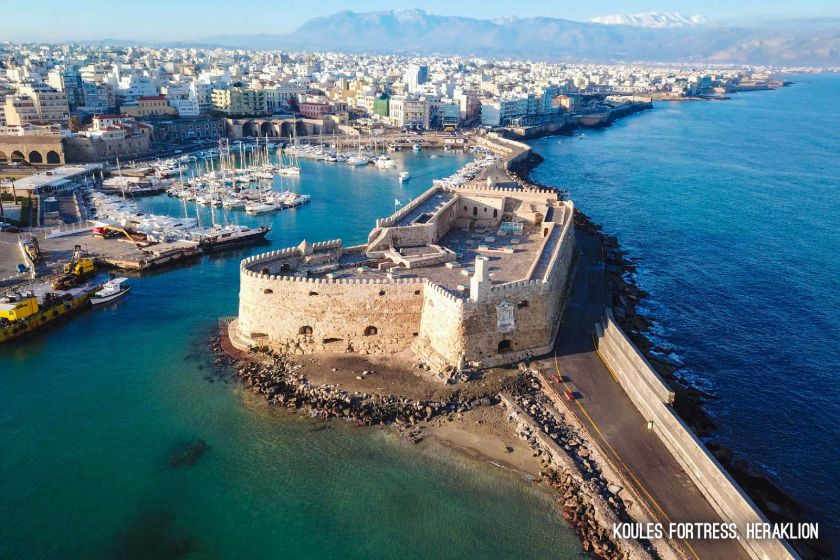Heraklion city, the capital of Crete, is a vibrant city that combines a rich ancient history with a lively modern vibe. Situated on Crete’s northern coast along the Aegean Sea, Heraklion is one of Greece’s largest cities and a popular gateway to explore the island’s natural beauty and archaeological wonders.
Historical Highlights
Heraklion’s history dates back thousands of years and is closely tied to the Minoan civilisation, one of the earliest advanced civilisations in Europe. The nearby Palace of Knossos, an ancient Minoan palace and archaeological site, is a major attraction. Thought to be the mythical labyrinth of King Minos, Knossos offers insights into a sophisticated society with advanced art, architecture, and technology dating back over 4,000 years.
Throughout the centuries, Heraklion was influenced by various powers, including the Romans, Byzantines, Venetians, and Ottomans. Each left a mark on the city’s architecture and culture. The Venetians, for instance, fortified the town with walls and built many impressive structures, such as the Koules Fortress, which still stands guard over the old harbour today. Walking through Heraklion’s Old Town, visitors can see remnants of this period, including elegant arches, fountains, and churches.
Cultural Scene
Modern Heraklion is a bustling urban centre with a lively mix of tradition and contemporary life. The Archaeological Museum of Heraklion is a must-visit, showcasing a vast collection of Minoan artefacts, including frescoes, pottery, and the famous Phaistos Disc. Other museums, such as the Historical Museum of Crete, offer deeper insights into the island’s recent history, including its Venetian, Byzantine, and Ottoman influences.
The city’s cultural calendar is packed with events, especially in summer. Visitors can experience the Heraklion Summer Arts Festival, which features music, theatre, and dance performances. The city also celebrates traditional Cretan music, a unique folk genre characterised by lyra and laouto (traditional string instruments) music and lively dances.
Culinary Delights
Heraklion’s food scene is a vibrant reflection of Cretan cuisine, famous for its simplicity, wholesome ingredients, and emphasis on seasonality. The foundation of Cretan cooking is rooted in the island’s rich agricultural tradition, with an abundance of high-quality, locally sourced ingredients. Olive oil, known as the “liquid gold” of Crete, is a staple in nearly every dish, enhancing flavours and adding health benefits. Other key ingredients include Cretan honey, wild herbs such as thyme and oregano, and a variety of fresh vegetables, including tomatoes, zucchinis, and wild greens, each contributing to the unique flavour profile of the cuisine.
Traditional tavernas in Heraklion offer a range of authentic Cretan dishes, preserving recipes that have been passed down through generations. Among the most iconic dishes is dakos, a flavorful yet straightforward appetiser made with barley rusks topped with juicy, grated tomatoes, creamy mizithra cheese, and a generous sprinkling of olive oil, sprinkled with oregano. Lamb with stamnagathi (wild greens) is another beloved classic, showcasing tender lamb slow-cooked with locally foraged greens for a dish that captures the essence of Crete’s mountains and valleys. Kalitsounia—small, savoury or sweet pastries filled with soft mizithra cheese and often flavoured with cinnamon or topped with honey—are a delightful snack or dessert that pairs beautifully with Cretan mountain tea.
Thanks to Crete’s ancient winemaking heritage, dating back over 4,000 years, the region around Heraklion is home to several renowned wineries. Many local vineyards offer wine-tasting experiences where visitors can sample unique Cretan varietals. Vidiano is a popular white wine characterised by floral notes and a rich, full-bodied taste, while Kotsifali is a red variety renowned for its soft tannins and fruity aromas. Liatiko, another indigenous red, is often used to produce both dry and sweet wines, offering a taste that combines fruity and spicy undertones. These wines complement the rich flavours of Cretan cuisine, making for a perfect pairing with local dishes.
Whether dining in a cosy taverna in the city or exploring wineries in the nearby countryside, visitors to Heraklion will surely experience the deep connection between the island’s history, land, and food.




